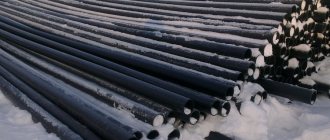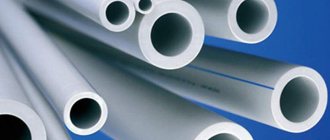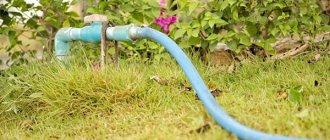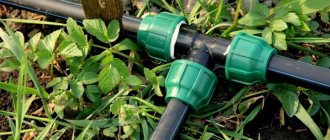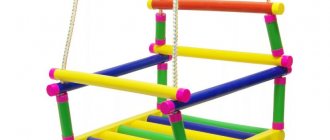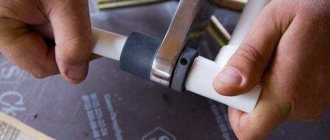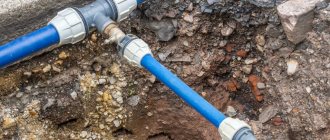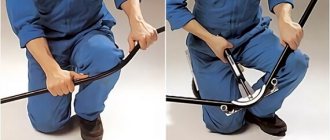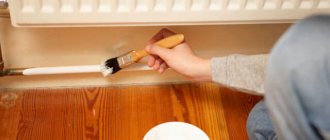One of the important stages in the process of preparing a water supply system for winter is its purging. The water supply system is designed in such a way that a special slope of the pipes facilitates complete removal of water through a tap located in the lower section. Despite this, there is a possibility that even a small amount of water will be retained in the pipes, which, if frozen, can cause damage to the water supply system, as well as shut-off or plumbing equipment. Let's find out more about the compressor for blowing pipes at the dacha.
Why do you need to blow the pipeline with a compressor?
The main problem with pipelines in winter is the freezing of water when the temperature drops. A change in the volume of media inside negatively affects the pipes, causing rupture of materials. A purge compressor will help avoid this by completely clearing the pipeline of media.
- water pipes running along the street between buildings;
- external automatic watering;
- water supply for swimming pools;
- water supply structures installed in an unheated room;
- automatic drinking bowls for animals.
The listed devices require timely purging of the water supply system. Cleaning is an important condition for the successful functioning of the structure.
The ability of the internal energy of air to be converted into kinetic energy during compression necessitates mandatory control over the level of air pressure entering the pipes during their cleaning. It is necessary to take into account the permissible pressure and air flow. Pressure exceeding 10 atmospheres must not be supplied to the internal pipeline.
It would be advisable to use it during work to dampen air flow pulsations and control excesses of its norm. A hydraulic accumulator is also capable of maintaining pressure at 10 atmospheres and ensuring water removal. Its application involves several stages:
- Air is pumped by a car compressor to the membrane of a hydraulic tank, which is connected to the water supply.
- Opening all water taps.
- Air supply from the hydraulic tank.
The result of purging will be a rapid flow of water from all previously opened holes.
Why blow out water pipes before frost?
The main problem of all country water pipes is freezing of water at subzero temperatures. Such a decrease in temperature negatively affects not only the pipeline, but also other equipment. An air compressor can help avoid such consequences; it can be used to clear water from the pipeline so that it does not freeze in it in winter.
This process removes water from:
- Water pipelines unprotected from frost (usually they run between nearby buildings);
- Automatic watering systems;
- Drinkers for animals operating in automatic mode;
- Structures for supplying water to swimming pools.
During the purging process, you need to understand that a pressure of more than 10 atmospheres cannot be supplied to the country pipeline. Otherwise, the pipeline may rupture or leaks will appear over time.
Preparing the dacha water supply system for winter
Sub-zero temperatures can damage pumping equipment, pipelines and household appliances if water remains in them before the frost. This is possible provided that the dacha is visited very rarely and the house is not heated. This means that water should be removed from wherever possible to prevent it from freezing. It is convenient to perform the procedure if drainage from the system was provided at the stage of design and installation of the pipeline.
For these purposes, the following elements are installed:
- at the water inlet to the house there is a tee with a tap in front of the check valve;
- on the pipeline indoors at the lowest points there are valves for draining water;
- if the pipes are installed under the floor, provide transition elements for connecting the compressor;
- on the pipe going to the water heater, in front of the check valve, there is a tee with a valve. Similar elements are installed at the output of the device;
- Mixers with one lever are not used, because in cold weather they burst if there is even a minimal amount of water left.
If you provide for all of the above, then draining the liquid and preparing the dacha for winter is much easier.
How to drain water from the system
When considering how and with what to blow out the pipes at your dacha before winter with your own hands, methods and methods for cleaning them from water, you need to understand the procedure for draining liquid from the pipeline entering the house. The process begins by unscrewing the tap, which is installed in front of the check valve, and characteristic sounds should be heard from the air passing through the system. If there is no special valve, the pipe is disconnected at the lowest point and the water is drained.
Next in line is the boiler. The device must first be cooled. If there are no elements for draining, unscrew the safety valve and connect a piece of hose. At the outlet, the nut is loosened, after which air begins to be sucked from the water heater, and the liquid flows through the hose. The latter is selected in such a length that the water is discharged outside the house.
Some water also remains in the washing machine. It is usually concentrated in the hose that connects the tank and the pump. The pipe is compressed and, by analogy with a rubber bulb, the remaining liquid is removed through the drain hose. After such manipulations, the machine is ready for wintering.
The shower system is also drained of water. To do this, unscrew the watering can and open the locking elements. Draining from the pipes supplying warm and cold water is carried out using a compressor, a conventional pump, or by blowing through the mouth.
Then they move to the toilet. First, remove water from the tank. To completely remove liquid from the water seal, use a pump or sprayer.
All siphons that are in the house are disassembled and the remaining liquid is removed. Unscrew the filter housings and also remove water. After these steps, the pumping station remains. It is de-energized in advance, the plug is unscrewed, and the water is poured into a prepared container. It is recommended to blow out the device with a compressor so that there is no residual water in the tank. This is necessary so that the rubber membrane is not damaged when the liquid freezes.
If the internal wiring around the house is installed horizontally, then the water will have to be removed only with a compressor, since it will not simply drain.
How to preserve street water supply
In a summer cottage, the water supply is often located on the surface of the ground and is used for watering, showering, and car washing. The effect of frost on pipes quickly renders them unusable. If there is a drain valve in front of the check valve, it is opened to drain the liquid. If such an element is missing, take out the pump and disconnect it from the water supply hose. When draining the liquid, all taps that can be disassembled are disassembled.
The container for the outdoor shower is emptied. If it is made of plastic, then it is advisable to completely remove it from the room. The water is also drained from the storage tank. If the water supply pipes are located at an angle, draining the liquid is easier. Otherwise, to avoid leakage, they are purged with a compressor.
Hoses and pipes related to the summer water supply are removed from the street for storage, completely removing water from them. If the water supply system has elements buried in the ground, they are also purged with a compressor. Parts located above the ground are dismantled and dried, after which they are moved indoors for the winter.
Plastic pipes are less susceptible to sub-zero temperatures than metal ones, but threaded elements are damaged. If there is no compressor, then it is better to lay the pipes from polypropylene, since they are damaged when frozen.
Preparatory work for the winter period in the bathroom
The first step is to remove the hoses and shower heads installed in the shower and then drain the water from them. A minimal preparation process is expected in sewers equipped with plastic sections, including plastic siphons, which create a very small water plug. It should also be noted that plastic has excellent thermal insulation characteristics, unlike metal and ceramics. The ability of plastic to deform will not allow the siphon to be damaged if the remaining water turns into an ice mass.
In the case of equipment with cast iron siphons, removing the remaining water is a mandatory procedure. What needs to be done in this case? Pushing water from the siphon is carried out using a kvach (otherwise known as a plunger). If this is not available, this task can be accomplished using a bicycle or machine pump. Alternatively, you can soak up the water in the drain with a regular rag. At the end of this process, the drain hole is tightly plugged with a stopper in order to avoid the appearance of sewer smell inside the room.
At the next stage, they begin to work on the toilet, which has the largest water plug, located in the knee bend of the bowl of the structure. Porcelain has very low deformation characteristics, which can cause the lower part of the knee to break off when residual water freezes in it.
Work order:
- It is necessary to drain the water from the toilet tank several times;
- Shut off the valve leading to the tank and completely remove any remaining water from it;
- Check that there is no water in the tank by opening its lid. If necessary, remove residues with a sponge;
- Scoop out the water from the toilet;
- To prevent sewer odors from appearing in the room, the hole should be plugged with a regular rag.
Compressors for blowing pipes in the country: types and features
Modern people are not ready to give up their usual comfort, even during a summer holiday in the country.
Therefore, the first thing that owners of suburban areas think about is laying and connecting communications - electricity, gas, water and sewerage.
It is important to note that even the highest quality installation is not enough for long-term and trouble-free operation of utility networks. It is equally important to properly prepare the system for winter
This will avoid “defrosting” of pipelines in an unheated room.
It is equally important to properly prepare the system for winter. This will avoid “defrosting” of pipelines in an unheated room.
Preparation for conservation can be done manually, but it is much more effective to use special equipment. That is why many owners of suburban areas prefer to buy a compressor for blowing pipes in their country house.
If you are also planning to purchase a unit, read the article written by a specialist from Energoprof Group of Companies.
Types, features, advantages of blowing equipment
Household appliances for the production of compressed air have no fundamental differences from industrial installations. The difference is only in power and performance. Otherwise, compressors designed for blowing pipes in a country house are very similar to professional equipment. For example, household models are the same as industrial units:
- are represented by piston and screw units, which differ in technical characteristics, operating life and other parameters;
- suitable for both purging and solving other problems - connecting pneumatic tools, inflating tires, etc.;
- have certain additional options - receiver, dryer, pressure gauge, control sensors, etc.
As for the features of compressors for blowing pipes in the country, they include relatively low pressure and power. Of course, the choice of unit should be approached individually, but on average, equipment with a capacity of about 100-150 l/min is suitable for private use.
The advantageous features of such units include:
- high reliability ensuring long service life;
- economical consumption of electricity, as well as oil and other consumables;
- light weight and compact dimensions, facilitating both operation and storage;
- low maintenance and care requirements;
- a wide range of models, thanks to which it is not difficult to choose a unit that is suitable both in terms of technical parameters and cost.
And finally, it is necessary to note the effectiveness of compressors for blowing pipes in the country. Using this equipment, you can quickly and effortlessly prepare the pipeline for preservation for the winter.
Procedure for purging
We know from our school physics course that when water freezes, it expands. Increasing in volume, it easily breaks a steel pipeline.
As for polypropylene pipes, they are more elastic and can often withstand pressure. However, in this case, the fittings are guaranteed to suffer.
That is why any plumbing system, regardless of the material, needs proper conservation.
- Turn off the water supply to the system or shut it off (for centralized water supply).
- Drain the water by gravity, remove the plugs, isolate third-party areas (if possible).
- Disconnect the boiler, boiler and other equipment from the pipeline of the water supply and heating system.
- Connect the nozzle of the compressor, designed for blowing pipes in the country, to the inlet of the pipeline and turn on the unit.
- Watch the exits - when water stops flowing from the pipe, wait a couple of minutes and turn off the equipment.
Operating rules and safety precautions
To ensure that the compressor for blowing pipes in your dacha serves for many years, adhere to the following recommendations:
- install the equipment only in a dry and clean place;
- after 7-8 hours of total work, change the oil;
- check the belt tension regularly;
- Use oil and consumables recommended by the manufacturer.
And one more important point! If the unit fails for any reason, do not attempt to repair it yourself. Even if there is a minor malfunction, use the services of a specialized service center. This will avoid even greater damage, and therefore the cost of restoration.
Ivan Chernov
Preparing other elements
In addition to pipes, preservation of other elements is also necessary for the winter. The controller located outdoors should be left in the off mode, but it should not be disconnected from the network. The heat from the transformer will protect against the formation of condensation under the casing. Controllers in premises are disconnected from the network. You need to remove the plates or discs from the weather sensors, and then drain the cup of any liquid that may have gotten there after rain.
The filtration system is also dismantled and cleaned of dirt and water. Pumping equipment located in an open space is completely dismantled, cleaned if necessary and stored in a dry room for winter storage. It would also be a good idea to perform preventive maintenance on pumping equipment. This can be done in the spring, but if any deficiencies are discovered in the fall, there will be more time to restore the pump's operation.
Preserving an automatic watering system for the cold period is considered to be quite a difficult job, in which various nuances and a certain sequence of actions must be observed. Also, when working, you must strictly adhere to safety rules, because failure to comply with them can lead to undesirable consequences. To preserve an automatic irrigation system, it is best to contact specialists who will carry out this work in accordance with all the rules. This will allow you to be confident in the safety of your irrigation equipment for the next season.
Preparing the country water supply for winter
The process of preparing a pipeline in a country house is not complicated in itself.
However, it is important to do all the steps in a certain order, otherwise you may make mistakes and not drain all the remaining water.
First of all, prepare buckets and other containers before starting work. Blowing with a compressor is carried out as follows:
- Turn off the water completely and then drain the system. At this stage, some of the water will flow out of the pipes by gravity, and the rest will have to be blown out;
- Disconnect other pipeline branches from the central one, so you can isolate them for further purging. Don't forget to install plugs, otherwise a lot of water will spill out;
- Connect the inlet pipe to part of the pipeline, and then plug in the air compressor. When the water stops flowing, the water cleaning is complete and you can turn off the air blower;
- Additionally, the pipes should be mechanically cleaned to remove accumulated deposits (usually minerals and salts).
It is better to carry out the preparatory work on purging the pipeline with a partner, so you can do it faster.
Stages of preservation of home water supply
Next, we will talk about the procedure for preserving the water supply system at the dacha for the winter. The whole process is done in several stages:
- Turn off the water at the entrance to the house;
- Open all plugs in the home branch of the pipeline;
- Prepare cans, rags and containers. Since water can escape from all open parts of the pipeline;
- Connect the compressor to the vented part of the pipeline;
- Turn on the compressor; when air comes out, it means the water supply system is preserved and therefore will not be damaged by frost.
What are the pros and cons of using a compressor to blow out pipes?
Any devices used by humans have advantages and disadvantages, compressors are no exception. The positive aspects of using a compressor for blowing pipes include:
Affordable price. In any city you can purchase inexpensive piston and screw compressors. Some services also sell used equipment. Such services include Yula and Avito
If you decide to buy a used compressor, be sure to pay attention to the accumulator, as they may be rusty;
High performance. Many models have a coaxial drive, so you can increase the operating speed several times;
Mobility
Small compressors are easy to maintain and use, as they can be easily dragged from place to place;
Unpretentiousness. All compressors are already filled with the required amount of lubricant at the factory, so there is no need for constant maintenance.
The disadvantages of using compressors to blow out pipes in a dacha include the likelihood of leaks in the future. This is due to the fact that some pipeline branches are often long. Therefore, it is necessary to create high pressure in the pipeline to expel water, otherwise some connections may begin to leak water in the spring.
Important! Conventional household compressors cannot be used for purging water pipes, as they are not designed for this purpose. In this case, the water supply system of the dacha will not be completely cleaned, and there is a high probability that water will remain in it
Only powerful specialized compressors can create the necessary pressure in order to completely remove water from the pipes.
Stages of conservation of wells and wells
In addition to preserving pipes in the country, it is also important to take care of preparing water sources for frost. Below we will tell you how to do it correctly.
Well
The water in the wells always has a positive temperature, so it does not need special conservation. If the well is shallow (up to 4 meters), then it is recommended to make a heat-insulating cover that will protect the well from freezing. It can be made from sheets of polystyrene foam or penoplex.
Well
Preservation of a well for the winter is done in several stages:
- First of all, remove all equipment from the well (they need to be stored in a heated room);
- Then you should blow out the pipes that go into the house;
- After checking the casing, you can fill it with a neutral composition (crushed stone with fine sand is perfect for this purpose);
- An antifreeze liquid must be applied to the top of the structure.
Regime for different periods of incubation
The development and hatching of chickens in the incubator lasts 20-22 days (the average is 21 days) and takes place in 4 stages. There is a calendar and table for the development of domestic chicken embryos:
- The first period is from the beginning of warming up to the 6th day. At this time, the embryo begins to form; stable conditions and frequent turns are important for it, which prevent the chick from sticking to the shell and dying in the first days.
- The second is days 7-11. The skeleton begins to form, the allantois closes in the acute part (embryonic respiratory organ). At this time, it is recommended to cool the chamber by a few tenths of a degree and reduce the humidity.
- Third – 12-18 days. Breathing increases and the incubator is ventilated to improve gas exchange. The chicken begins to pull its head towards the air chamber.
- From the 19th day until the end of biting. The last period is the completion of hatching chickens in a home incubator.
The incubation modes for chicken eggs at each stage have their own characteristics. The main parameters that need to be regulated are temperature and humidity.
Incubation table for chicken eggs and features of modes in different periods:
| Temperature with a regular thermometer | Humidity | Number of revolutions | Ventilation | |
| 0-6 days | 37.8-38 °C | 60-70% (55% on day 5) | Every 1-2 hours with a short break at night | – |
| 7-11 days | 37.5-37.7 °C | 35-46% | Every 4-6 hours | 2 times a day for 15-20 minutes |
| 12-17 days | 37.3-37.5 °C | 70-80% | 4-9 times a day | – |
| 19-21 days | 37.2 °C | 70% | – | – |
The incubation regime for chicken eggs at home is changed gradually. To raise the humidity, place a rag in a tray with water. Reduce humidity levels by covering the surface with a piece of foam. In the initial period, a gradual decrease in humidity indicators is carried out from the 4th day. Already from 10 days they begin to raise it.
When ventilating the chamber during incubation, monitor the air temperature. It should not drop too much to prevent the material from cooling. It is recommended to preheat the room in which the chicks are “hatched”.
It is good if the farmer turns the material every hour in the first week. This schedule is optimal because the hen does just that in her nest. Not everyone manages to adhere to this rule, so it is better to purchase an automatic device. Then it is easy to reduce the time spent turning eggs and increase the hatchability rate of chicks.
Let's take care of the cellar
If your country house has a cellar, you also need to take care of it. First of all, you need to tidy up here: sweep out the garbage, remove cobwebs from the walls, thoroughly disinfect and ventilate - unless, of course, you did this earlier, before storing the crop. To disinfect the cellar, use special smoke bombs. And don’t neglect this work even if you don’t use a cellar at your dacha: many problems at home start from here. Don’t forget to thoroughly dry and protect the wooden shelves in the cellar from mold and rot by treating them with copper sulfate (we prepare a solution of 6 liters of water and 600 g of vitriol). If possible, whitewash the walls of the cellar with lime water prepared from 2 kg of lime diluted in 6 liters of water. If you do find mold somewhere in the cellar, wipe it with 40% formaldehyde. Checked - it will help.
Kitchen area
Absolutely blank facades turn the idea of traditionality upside down, becoming part of the architecture. They are ideal for the concept of minimalism, preferable for the design of a kitchen unit in a studio apartment in the area of 20 square meters.
If the look with separate levels is more common, then the most noticeable area, the kitchen apron, takes on the function of additional decor. Skinali is a practical, at the same time limitless, way of transformation.
The L-shaped set, which will be chosen by those for whom it is important to have a full-fledged kitchen for regular use, has its own characteristics. They are sometimes not noticeable in the photo, but are reflected in the overall area:
- different width of wings;
- no beveled corner;
- maximum height.
The bar counter will serve for snacks and will become a conditional divider between the culinary area and the living area. The latest models are quite capable of replacing a dining table with a familiar, classic look.
Design of a one-room apartment 36 sq. m - interior ideas
What space saving techniques are implemented in the kitchen:
- retractable, folding tabletop or roll-out cabinet;
- folding chairs;
- miniature versions of technology.
Compressors and their variants
A compressor is a kind of air pump that can operate in two directions. The scope of its application is not limited to blowing.
In many household and industrial areas, from construction to mechanical engineering, it is advisable to use such installations. Therefore, they are produced in various versions, differing in design features, operating and technical parameters.
Piston compressor
The basis of the design is a piston-type element that increases air pressure by compression, compressing the air with a piston cylinder, after which the compressed air mass is fed into the pipes. The piston apparatus is inexpensive, easy to operate, consists of simple parts, so repairing it if necessary is quite easy and not expensive.
This mechanism has some disadvantages. These are, for example, low, low productivity, high noise levels.
Scroll compressor
The device is characterized by smooth operation and reliable operation. Thanks to the perfectly balanced moving spiral, vibrations of the installation tend to zero. The scroll compressor for purging water supply pipes has no dead volumes, therefore its volumetric efficiency increases.
The high reliability of the spiral device, in contrast to piston mechanisms, is ensured by less pulsation and the number of moving elements. You can understand more clearly how scroll compressors are designed and what the principle of their operation is based on by watching the video:
Screw compressor
Refers to rotary equipment and contains a pressure screw in its design. The screw installation kit includes a noise-insulating casing, so it operates almost silently.
The device is designed to operate autonomously and does not require constant monitoring and maintenance. Economical consumption of lubricants and high performance make such compressors indispensable for blowing pipes in the country.
Diaphragm compressor
In such devices, air compression occurs under the action of a membrane. It moves back and forth, thereby acting as a piston. By fixing the membrane to the working reservoir, there is no need to use additional parts (seals, piston rings, other elements).
Such devices have the following qualities:
- tightness;
- resistance to the destructive effects of corrosion;
- high compression;
- reliability of design;
- ease of use;
- safety of operation.
Unlike others, in membrane mechanisms the forced air is in contact only with the inside of the chamber. The design provides for the presence of a small receiver that acts as a compressed air storage device and allows you to regulate its supply rates.
Using the example of the model discussed in the video, you can understand the general principle of operation of membrane compressors:
What equipment is needed to blow out pipes?
Plumbing compressors come in a variety of varieties, and their use is not limited to purging pipelines. Below we will tell you in detail about existing compressors, and then you can make the right choice.
Scroll compressors
These devices are primarily characterized by their high reliability and long service life. They are so called because the main element of the installation is a special spiral, which is perfectly balanced, so vibrations are practically not felt during operation.
There are few moving elements in the installation of a scroll compressor, so no extraneous pulsations are observed when the pressure increases. This compressor differs from the piston compressor in its increased volume.
Diaphragm compressors
In such devices, air compression occurs under the influence of a membrane. In this installation, it performs a reciprocating motion, and thus performs the same functions as a piston.
Diaphragm compressors differ:
- stable long-term work;
- long service life;
- ease of use;
- corrosion resistance;
- safety to use.
Inside such a compressor there is a dense rubber chamber; it plays the role of the main air storage device. Therefore, a membrane-type compressor does not rust, which is why it lasts much longer.
Piston compressors
The operating principle of this compressor can be compared to the combustion chamber of an engine in a car. After all, air is also compressed here as in cylinders. Although the design of a piston compressor is quite simple, therefore these models are inexpensive and anyone can purchase them.
Negative aspects of the unit: short operation, high noise level.
Screw compressors
A pressure screw is installed in the design of this device. Almost all models are sheathed on the outside with sound-insulating material, so screw compressors operate almost silently.
The screw compressor needs to be lubricated once every 3 months, but this is only in case of active use. It is this feature that makes this compressor an indispensable assistant in the country when blowing pipes.
Device types
Equipment for purging must be selected depending on the complexity of the pipeline and its length. There are different compressors that differ in power and operating principle.
Classification of equipment that pumps air is made not only by internal design, but also by other factors. Separation by operating conditions:
- Stationary devices. They need to be connected to the network to work.
- Mobile compressors. They are equipped with an internal combustion engine, which is fueled with liquid fuel. It doesn't need to have a network connection.
There are models that are equipped with cooling of working elements. If it is not there, you need to work intermittently.
Piston
The design contains piston cylinders in which air is compressed. The equipment operates on the principle of an internal combustion engine. Advantages:
- low price;
- simplicity of design.
One of the disadvantages is the loud noise during operation.
Double piston compressor for purge
Spiral
Inside the metal case there are two spirals that are responsible for the working process. They are characterized by small dimensions and low power. Used for cleaning short pipelines.
Screw
The design consists of two rotating screws in a metal casing. Advantages:
- high power;
- low power consumption;
- no noise during operation.
Membrane
Analogue of piston equipment. Instead of pistons, the design has membranes. Additionally, a receiver is connected, which accumulates compressed air. Consumes a small amount of electricity, produces high power.
Compressors and their variants
The process of purging the water supply can be carried out using compressors, the operation of which is based on various methods.
Piston compressor
Similar to the operation of an internal combustion engine, in which a combustible mixture is compressed, in this compressor piston cylinders are used to compress air. The positive aspects of a piston compressor include its simple design, affordable cost and maintainability. The negative aspects are the inability to work for a long time and noise during operation.
Scroll compressor
It is distinguished by its small size, which makes it possible to operate it in small rooms, and low productivity.
Screw compressor
Air injection occurs due to the parallel rotation of two screws of a special configuration. The operation of this type of compressor is characterized by a low noise level and low energy consumption due to low friction between the screws. The advantage of a screw compressor is considered to be high energy efficiency, which is characterized by a large volume of air that is pumped per unit of energy expended. Such compressors are expensive, and their repairs are carried out exclusively by services.
Diaphragm compressor
This compressor is similar to a piston compressor, the difference is the use of a thin membrane instead of a metal piston. The crank mechanism is the “engine” of the membrane. The compressor is distinguished by the creation of low pressure and a very low level of performance.
Industrial compressor
In their design, compressors often have a small receiver, which looks like a reliable steel tank that stores compressed air. Thanks to the receiver, it is possible to raise the pressure to high levels, which cannot be done with a single compressor, and create a spare volume of air. As a result, you can get an effective alternative to a powerful, expensive compressor.
Compressors are required to be equipped with pressure gauges and special means for adjustment, which are mandatory elements that allow you to monitor and adjust the pressure level. Once the water supply has been purged, all drain valves located in the lower sections of the pipeline must be left open without exception.
Blowing pipes without using a compressor
Blowing out a country water supply system without a compressor can be done in different ways. This topic is relevant for many homeowners who do not live at their dacha in winter. If the water supply system was equipped with polypropylene pipes that went 0.7 m into the ground, then there is a possibility of them freezing.
As an example, we can consider pipes with a diameter of 20 mm. They are laid from the well to the bathhouse. On the second floor there is a storage tank with a volume of 0.5 m3. Next, the wiring goes through the bathhouse and goes to the house, while it also goes deeper into the ground.
Due to the fact that the pipes are located at the depth of the frost line, there is a high probability of their rupture from frost. That is why it is necessary to carry out purging before the start of the winter season. For this, you can use an old model vacuum cleaner, which has two holes, one should provide suction, the other should provide blowing. However, this method has two disadvantages. One of them is expressed in low pressure, the other is the impossibility of a hermetically sealed connection between the hose and pipe.
Making your own compressor
To make a simple device with your own hands, you will need the following materials:
- old fire extinguisher or gas cylinder;
- electric motor with pulley;
- compressor from a truck;
- drive belt;
- fuel line filter;
- pressure gauge;
- pressure switch;
- starting machine;
- depending on the circuit - a set of adapters (fittings);
- clamps;
- hoses.
Assembly sequence:
- We prepare the receiver: at the bottom of the body we equip supports on which the entire structure will stand. We mount a platform on top for installing the compressor and electric drive.
- We select the engine so that a pulley for a belt drive can be attached to the working shaft.
- We unscrew the standard tap from the cylinder and insert the crosspiece in its place.
- We install a compressor and an electric motor on the upper platform. We put a belt on the pulleys, tighten them, and fix them.
- In front of the receiver, on the air hose, we mount a pressure switch.
- We insert the compressor pipe, pressure gauge and outlet valve into the elbows of the cross.
- We connect the power supply to the engine through the automatic starter.
- We connect the main line, supply current, and use the unit.
Review of some compressor models: “Caliber KMK-2300/50U”
This model has a cost of 12,400 rubles. This is equipment that includes a pressure switch. It is responsible for turning off the engine if the pressure in the receiver reaches a critical level of 8 bar. If this value drops to 6 bar, the device will automatically start the engine. Long and stable operation is ensured thanks to an asynchronous motor. The condensate is drained through a tap located at the bottom of the receiver.
Equipment required for purging
In the absence of a powerful compressor, you can take advantage of the ability of air to accumulate kinetic energy during the compression process, which allows you to use a receiver for these purposes. The hydraulic accumulator also has the ability to stabilize the water supply in taps, as well as hold air at a pressure of 10 atmospheres. The technology of its use consists of the following steps:
- Using a car compressor, the entire air flow is slowly passed into a bulb or into the membrane of a hydraulic tank, which is connected to the water supply system via a hose;
- Open the existing taps at all water points;
- They begin to supply air from the hydraulic tank.
The result of blowing will be noticeable immediately, as water will begin to quickly and noisily come out of the pipe openings.
A popular way to solve this problem is to use an overinflated bus inner tube or a heavy-duty vehicle inner tube. Such products are able to withstand high pressures (for example, 3 atmospheres or more), which makes them suitable for purging. This volume of air will not be enough to clean the entire rather extended system of rather complex pipes from residual water. You can fill the receiver chamber with air using an ordinary foot pump, even in the absence of electric current or a compressor.
You can also use a car compressor, which will help raise the pressure in the water supply system and then open all the taps. The use of this option will become very relevant in the absence of a rubber chamber or hydraulic accumulator. However, it should be borne in mind that in this case there is a possibility of leaks, which means that it must be carried out very carefully.
You should not test a household vacuum cleaner as equipment for purging water pipes. For these purposes, it is worth acquiring specialized equipment and purging using proven technology. Other methods will not guarantee a complete absence of water in the water supply system.


